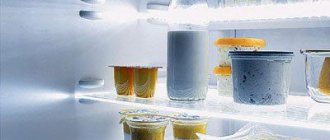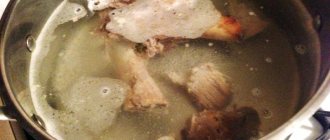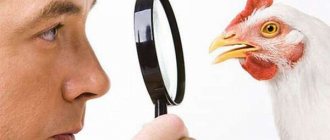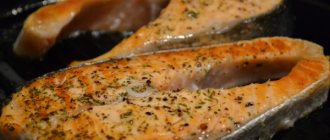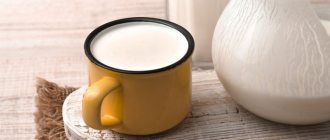What is Helba, 20 beneficial properties, how to brew and drink, research
Helba is an annual plant of the Legume family. The first information about it was found in the records of the ancient Egyptians dating back to 1550 BC. Helba is mentioned as one of the ingredients in the composition for embalming, anti-burn and to facilitate childbirth. In Ancient Greece, decoctions from the plant were given to gladiators before battles, and the philosopher Avicenna called it his favorite medicinal herb.
Currently, helba is known as fenugreek, shambhala, fenugreek, “Greek hay”, abish, hilbe, Egyptian yellow tea, methi. It is grown in the Caucasus, Eastern Europe, Turkey, Egypt, Saudi Arabia, Ethiopia, and Central Asia.
Helba looks inconspicuous. This is a shrub up to 60 cm high with oblong leaves arranged in 3 layers. It has small flowers, from which elongated pods with yellow grains are formed, shaped like pomegranate seeds (see photo).
There are about 100 types of helba in total, the most famous are blue and hay. The first is included in Indian sauces and seasonings, and the second is known as a remedy. It is even mentioned in the Islamic Sunnah as a medicine or “faraj” - the salvation recommended by the Prophet Muhammad.
However, helba is popular not only in the East. It is often found in European traditional medicine recipes, as well as in modern drugs for various diseases. The beneficial properties of the plant, possible harm, options and rules of use are described below.
What is Helba
Helba is a plant that historically grew in the territory from Africa to the Indian Peninsula, and subsequently also in Southern Europe, Asia, and South America. Thanks to such a wide geography, it has many names: fenugreek (with various definitions - Greek, hay, etc.), shamballa, fenugreek, chaman, Greek hay, camel grass, etc. Scientists of antiquity drew attention to the amazing fruits back in 4000 BC. They are mentioned in the scientific works of Egyptian, Indian, Greek, Arab, Roman, and Chinese healers. Traces of beans were found in the tombs of Egyptian pharaohs (and they, as you know, ordered only the most valuable things to be placed there), and their description was found in ancient Roman manuscripts containing instructions for caring for cattle.
The consumption of beans was elevated to the rank of a cult in ancient Egypt. Therefore, the drink made from them has a second name – yellow Egyptian tea. Helba is used in various fields: cooking, perfumery, cosmetology, production of spices and medicines. It also makes a very tasty and healthy tea. In ancient China, it was called “the cure for a thousand diseases”, since in terms of the amount of vitamins and microelements there is little that can compare with it.
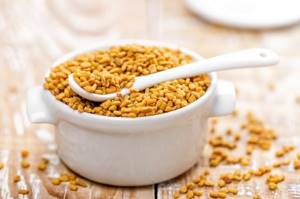
Helba has been known since ancient times for its properties and taste.
Tea composition
The calorie content of fenugreek seeds is 233 kcal per 100 g. This portion of the product covers 60-61% of the daily nutritional needs of the human body. As they say, the uniqueness of the plant is obvious.
Helba has been valued by physicians since ancient times due to its rich internal composition, including:
- amino acids – isoleucine, lysine, tryptophan, etc.;
- flavonoids – hesperidin, rutin;
- polysaccharides – starch, pectins, galactomannan, cellulose, hemicellulose;
- vitamins of groups B, C, A, PP;
- micro- and macroelements – potassium, calcium, sodium, magnesium, iron, zinc, selenium, phosphorus, copper, manganese;
- fats, polyunsaturated fatty acids;
- carotenoids, trigonelline - precursors of vitamins A and B.
It also contains a large amount of essential oils, tannins, coumarins, phenolic and hydroxycinnamic acids, and enzymes. Egyptian tea is rightfully considered a leader in the content of plant proteins, vitamins and the phytoestrogen diosgenin (a plant analogue of the ovarian hormone).
Beneficial features
The beneficial properties and composition of Helba are naturally interrelated. The active substances of the seeds affect certain organs or systems of the human body, helping to normalize their functioning. Therefore, they were (and are) used not only as a preventive measure, but also for the treatment of various diseases.
Yellow tea has a beneficial effect on:
- respiratory organs – promotes the treatment of respiratory, viral, colds, bronchitis, asthma, sinusitis, tuberculosis, pneumonia, has an antipyretic effect;
- cardiovascular system – reduces cholesterol levels in the blood, increases vascular elasticity, improves blood flow, normalizes blood pressure;
- organs of the gastrointestinal tract - accelerates metabolic processes, relieves digestive disorders (flatulence, constipation, diarrhea), helps in the treatment of gastritis, ulcers, gastroenteritis, cholecystitis, pancreatitis, cholelithiasis;
- genitourinary system – improves the removal of toxins and waste, has a mild diuretic effect, helps establish the cycle in women, restores reproductive ability, is used to treat urolithiasis, infectious and inflammatory diseases of the kidneys, bladder;
- bones and joints – effective in the treatment of arthritis, gout, osteomyelitis, osteochondrosis;
- skin – helps get rid of rashes, acne, greasy and flaking;
- oral cavity – prevents the development of caries, helps get rid of gum disease, serves as a natural rinse;
- nervous system – helps get rid of sleep disorders, depressed, depressed, stressful conditions, increases the overall tone of the body.
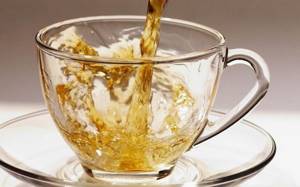
Helba tea contains a large number of useful elements
Tea is recommended for regular consumption to maintain health. And especially in the presence of sexual disorders, anorexia, obesity, type 2 diabetes, and nervous disorders. It will help you recover faster during periods of rehabilitation after surgery, injury or illness, and also help women get back into shape faster after childbirth.
By the way, Helba is extremely useful for women: gynecologists recommend drinking it for the prevention (and especially during the treatment process) of mastopathy, endometriosis, uterine fibroids, infertility, cysts, polycystic ovary syndrome, and menstrual irregularities. Of course, taking into account existing contraindications.
Harm and contraindications
You should drink yellow tea with caution, since the large amount of active substances in it can have the opposite effect on human health . For example, if he has an allergy or individual intolerance to any of them. Or it will exceed the recommended intake.
You will need to abstain from Helba if you have any of the following diseases or discrete conditions:
- Iron-deficiency anemia;
- type 1 diabetes mellitus;
- liver diseases;
- low blood pressure;
- the presence of stones in the gall bladder;
- pregnancy (especially in the early stages);
- tumors in the uterus;
- vaginal bleeding.
A doctor's consultation is required for people taking a course of medications that include thyroid hormones and anticoagulants. An overdose of the drink can lead to bloating, increased gas formation, and intestinal disorders.
Beneficial features
The most valuable raw materials of helba are considered to be grains. Refreshing and healing teas, seasonings, and cosmetics are prepared from them. However, the leaves and stems of the plant also provide benefits. They are added to salads, decoctions, and infusions. To understand why the ground part and seeds of helba are known in different parts of the world, just look at the list of positive properties:
- Strengthening the immune system.
- Removal of mucus from the lungs.
- Relieving fever during colds.
- Fight inflammation.
- Reduced blood glucose levels.
- Normalization of the gastrointestinal tract.
- Accelerates the removal of toxins from the body.
- Activation of metabolic processes.
- Eliminate constipation.
- Improving brain function.
- Giving elasticity to blood vessels.
- Reducing the likelihood of developing cancer.
- Activation of the urinary system.
- Reducing nervous tension.
- Improving reproductive function.
- Normalization of blood pressure.
- Accelerating the cell recovery process.
- Activation of hemoglobin production.
- Preventing the formation of blood clots.
- Decreased appetite.
How to use fenugreek
The classic and simplest recipe is:
- Brew a level tablespoon of seeds in 200 ml of boiling water.
- After cooling, strain the infusion.
- Consume during the day in its pure form, diluted with water or milk.
In addition to the positive preventive and medicinal properties, it is worth noting the pleasant taste and aroma of the parts of this plant. After all, fenugreek is a seasoning that is very actively used in cooking.
Fenugreek add:
- in soups, salads, cereals;
- bakery products;
- sweet pastries;
- cheese, cold snacks;
- tea, other warming drinks.
Different parts (leaves, seeds) of fenugreek serve as an indispensable additive to enhance the taste, aroma and benefits.
Fenugreek is stored dried so that it can be used as a seasoning all year round.
Fenugreek seeds are added to food raw, roasted, dried, ground or crushed.
No wonder this plant is popularly called “mushroom grass”! When adding fenugreek leaves or seeds to soups, vegetable salads, sauces and dressings, dishes acquire a subtle, subtle mushroom flavor. The aroma of this seasoning has a beneficial effect on appetite and saturates food with bright spicy colors. Trying dishes and drinks with fenugreek leaves and seeds is doubly pleasant, knowing what invaluable benefits such a supplement brings to the human body.
Contraindications and possible harm
Instructions for the use of helba preparations most often indicate that the plant should not be used if you are allergic to the main component. However, the list of contraindications is wider:
- Diseases associated with increased levels of estrogen in the body. The plant activates the production of the hormone, and therefore provokes an exacerbation of the pathology.
- Vaginal bleeding. Helba interferes with the coagulation process and can aggravate the symptom.
- Insulin-dependent diabetes. The herb increases sensitivity to the drug, which leads to the appearance of signs of excess insulin in the body.
Use Helba for the treatment and prevention of pathologies only after consulting with your doctor and calculating a safe daily dose.
Contraindications to the use of fenugreek
Fenugreek also has contraindications that should be taken into account.
- The plant is not recommended for pregnant women, as it can cause miscarriage.
- Increased blood clotting.
- Bronchial asthma.
- Tendency to food allergies.
- It is also not recommended to use it if there is a high level of prolactin and estrogen in the blood.
Fenugreek is a useful plant that can significantly improve your health. But its reception should be carried out according to the recommendations. This is the only way to normalize health, avoiding the negative consequences that arise from improper use.
Feature benefits for women and men
Some medicinal plants are called “female” or “male”. Helba is universal, equally useful for representatives of the stronger and weaker sex.
Effects on men:
- Infertility. Drinks with shamballa stimulate the production of sperm, improve their quality, and help eliminate inflammation that causes reproductive dysfunction. Take the remedy no more than 3 times a day.
- Potency. The plant contains substances that stimulate the production of testosterone and relieve genitourinary diseases. To maintain potency, drink tea from the seeds 3 times a day, 200 ml, or take 2 tablespoons of powder mixed with a glass of milk.
- Physical exhaustion. Helba tones the body, relieves insomnia, and helps restore strength. To recover after hard work, drink a cup of tea. Sprouted seeds help get rid of muscle pain and activate growth.
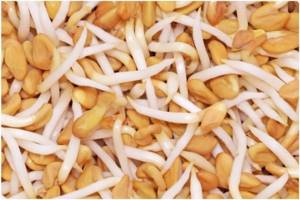
Useful properties of helba for women, how best to take it:
- Increased lactation. Promotes the production of prolactin, so during breastfeeding you can drink a cup of bean tea once every 2 days.
- Reducing symptoms of PMS and menopause. Phytohormones contained in the plant help reduce uterine spasms during menstruation and eliminate estrogen imbalance during menopause. Relieves pain during menstruation and helps regulate the cycle. The sedative and anti-inflammatory effects of helba contribute to improving women's health. Drink 1 cup of seed tea 3 times a day.
- Breast augmentation. One of the factors influencing bust size is high estrogen content. Helba stimulates hormone production and is used to maintain breast beauty. According to women, the bust becomes larger with regular consumption of sprouted or roasted seeds of the plant.
- Vulvitis. For inflammation of the external genitalia, douching and hygiene procedures with helba infusion stimulate the restoration of damaged tissue, block the spread of infection, and relieve itching and discomfort.
- Infertility. The plant helps speed up conception because it activates the work of the ovaries. To get pregnant, take Helba tea before ovulation or after menstruation.
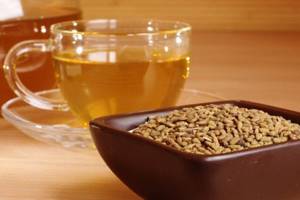
Chemical composition of fenugreek
Fenugreek seeds contain a large number of biologically active substances:
- phytosterols are the main active ingredients of the plant, have a hormone-like effect on the body, regulate the functioning of the digestive organs
- alkaloids
- minerals
- steroid saponins
- vitamins (PP, C, B1, B2)
- flavonoids
- tannin
- mucus
- squirrels
- bitterness
- fatty oil
- essential oil
Fenugreek oil contains a high concentration of polyunsaturated fat (approximately 84% by weight). According to some studies, people who eat a higher proportion of polyunsaturated fats in their diet (compared to saturated and monounsaturated fats) show healthier hearts and better blood vessel recovery from oxidative stress. (3)
Fenugreek seeds are also rich in dietary fiber, which accounts for 45-50% of the weight. High-fiber diets support good overall health, aid digestion, and reduce fat and sugar in the blood. (5)
Fenugreek seeds contain many nutritional components, the main ones being proteins, potassium, starch, sugar, essential oil, vitamins A, C and B and enzymes. In addition, the plant contains all the essential amino acids.
Minerals (mg):
- potassium - 770;
- calcium - 176;
- magnesium - 191;
- iron - 33.5;
- phosphorus - 296;
- sodium - 67;
- zinc - 2.5;
Vitamins (mg):
- vitamin C - 3;
- vitamin B1 - 0.32;
- vitamin B2 - 0.3;
- vitamin B9 (folacin, folin, folic acid) - 57;
- vitamin PP - 1.6.
The nutritional value
Nutrient content in 100 grams of fenugreek seeds:
- Fats (gr.) - 6.4;
- Proteins (gr.) - 23;
- Carbohydrates (gr.) - 58.4, including fiber - 10;
Energy value 1 tsp. Shambhala seeds - 12 kcal.
Pregnant and lactating women, research
Helba is not recommended for use during pregnancy. The plant stimulates uterine contractions and can cause miscarriage. Doctors believe that Shambhala makes childbirth easier. However, if bleeding occurs, it becomes dangerous because it slows down the resolution of the problem.
When breastfeeding, teas with helba are used to enhance lactation. The effectiveness of the product among women is proven by studies by Palestinian scientists. In 2020, they published the results of work aimed at collecting feedback from gynecologists and nursing mothers about the plant’s effect on the rate of breast milk production.
- accelerating the body's recovery after childbirth;
- normalization of digestion;
- increasing the volume of breast milk;
- antioxidant effect;
- improving the body's defenses;
- breast cancer prevention;
- eliminating constipation;
- normalization of hormonal levels.
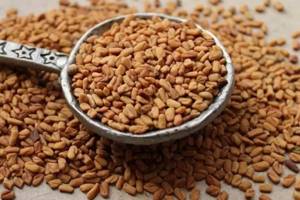
Disadvantages of the plant that appear when used incorrectly:
- decreased blood clotting rate;
- possible worsening of asthma symptoms;
- provoking nausea, vomiting, diarrhea;
- sweating;
- mastopathy.
Safety and side effects
Despite the full range of beneficial properties, fenugreek also has contraindications. To be healthy and harm the body, you should pay attention to them, especially when taking medicinal dosages.
- Excessive consumption of fenugreek can create a risk of miscarriage during pregnancy; the substance oxytocin causes uterine contractions.
- Allergic reactions are possible.
- Since shambhala lowers blood sugar levels, in diabetics in combination with taking insulin medications it can become too low.
- Too high a dose may cause nausea, bloating and diarrhea.
- There are several possible side effects of fenugreek. If taken orally, it may cause gas, bloating and diarrhea. It can also cause irritation when applied directly to the skin, so always test a small area first.
- Even though it has been used to induce labor, women should always exercise caution when taking fenugreek during pregnancy. Be sure to talk to your doctor about this before use.
- It is also important to note that fenugreek may cause harmful effects that can thin the blood and cause excessive bleeding in some people. Those who have underlying bleeding disorders or who are taking blood-thinning medications or anticoagulants should not take it without the approval of their doctors. Signs of excessive bleeding include slight breakage of the skin, vomiting blood, or dark stools.
There is one documented case of a person who developed a pulmonary embolism, or the formation of a blood clot in the lung, after taking a special testosterone supplement containing fenugreek. But the mechanism of development of this condition has not been clarified. (20)
According to some scientists, people who are allergic to chickpeas (a legume called Cicer arietinum) may also have adverse reactions to fenugreek because the two plants contain similar proteins and allergens. Some patients have reported wheezing and airway spasms after consuming fenugreek. (4)
Fenugreek seed extract has been linked to the development of hyperthyroidism in rats. If you have thyroid problems, consult your doctor before using fenugreek. (21)
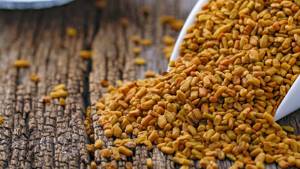
Traditionally, fenugreek was used to induce pregnancy. Due to its potential to affect uterine contractions, fenugreek should not be eaten or taken during pregnancy. While fenugreek is a relatively common food, there is little formal research into its effects during breastfeeding. (22, 4)
Fenugreek contains compounds that act as estrogen in the human body. People diagnosed with hormone-sensitive tumors (such as prostate cancer or breast cancer) should avoid taking fenugreek. (22)
The following list of potential interactions should not be considered exhaustive. Other substances may interact with fenugreek. Better to be safe than sorry! Always talk to your doctor before you start taking a new supplement or substance to avoid dangerous or unexpected interactions.
Because of its blood-thinning properties, fenugreek seed may increase the potency of the drug warfarin, a commonly prescribed anticoagulant. Although the observed association was small, it may increase the risk of blood loss from even minor cuts. (23, 4)
The sticky fiber in fenugreek seeds, which helps it moisturize dry skin in humans, could also potentially coat the walls of the digestive tract, blocking the absorption of medications taken orally, according to some scientists. Therefore, it is important to talk to your doctor before taking fenugreek along with prescription medications. (4)
Because fenugreek may lower blood glucose levels, it should not be combined with glucose-lowering medications such as insulin. This combination has the potential to cause hypoglycemia (abnormally low blood glucose levels), which may cause unsteadiness, dizziness, and nausea, especially in older adults. If you occasionally experience hypoglycemia, talk to your doctor before taking fenugreek. (4, 24, 25)
Combinations
Some athletes take fenugreek seeds and creatine supplements in an attempt to improve athletic performance. In a study of 47 trained men who received 5 grams of creatine and 900 mg of fenugreek, there was an increase in upper body strength and improved muscle composition in the body. But the study does not specify to what extent this result may be due to fenugreek. (35)
A combination of fenugreek and Lespedeza seed extracts was given to 44 apparently healthy men with low testosterone levels. After 8 weeks of taking 400 mg of the combination supplement per day, about a third of participants showed significant improvement in severe androgen deficiency. Much more research will be needed to replicate and interpret these results. (36, 37)
Fenugreek is often sold in combination with other supplements, such as thistle or fennel, for the purpose of increasing breast milk production in nursing mothers. The effectiveness of these combinations has not yet been studied.
Classic recipes for brewing Helba tea
The video also demonstrates a quick method for brewing helba with milk.
Recipe for bust enlargement
The latter technique is the most popular, since at the same time as improving the bust of girls, they treat female diseases.
Recipe:
- wash the seeds;
- dry the raw materials in a frying pan until a golden hue appears;
- Pour 2-3 teaspoons into a deep container and fill with hot water;
- cook in a steam bath or low heat for 5-6 minutes.
Drink 1 cup 3 times a day.
Price of tea and where to buy it
You can buy yellow tea in Egypt. Local residents willingly treat tourists, so you can try this amazing drink everywhere: at a party, in a cafe or restaurant, and even in a tea shop. Guides can always help you purchase yellow tea. Sometimes fenugreek seeds are sold in spice shops (both in Egypt and Russia). In Russia, yellow tea from Egypt is available in some specialized online stores, but, unfortunately, it is not easy to find such stores. So if your friends and relatives are going on a trip to the land of the pharaohs, then be sure to ask them to bring them this wonderful tea. The price reaches 324 rubles per 100 grams; in Egypt you can buy 1 kg of yellow tea for about $1.5.
Video
The benefits and harms of helba for diseases
The plant has a wide list of indications for use. However, for each disease, take into account the specific effects of helba on humans:
- Angina. Gargling with a concentrated decoction speeds up recovery because it stops the spread of infection and relieves inflammation and pain. During treatment, avoid swallowing the drink, since it is prepared at the rate of 50 grams of beans per 500 ml of water. This concentration is useful when used topically, but if ingested it causes diarrhea and allergies.
- Bronchitis. Herbal tea promotes the release of phlegm, reduces fever, and activates the body's defenses. The result of the treatment appears faster if the helba is brewed in a thermos in equal parts with thyme and marshmallow root, filled with hot water. Take 1 tablespoon of the product up to 8 times a day. You cannot drink the entire dose at once, as it can provoke an allergy and a severe coughing attack.
- Stones in the kidneys. A decoction of dates and helba seeds eliminates congestion in the kidneys and reduces the likelihood of exacerbation of the disease. To prepare, we use 5-6 fruits, 0.5 teaspoon of grains, 400 ml of water. Cook over low heat until 1/3 of the liquid has evaporated, strain after cooling. Drink 100 ml 3 times a day. The drug should not be taken during an exacerbation of urolithiasis, since the active functioning of the excretory system creates a dangerous load on the kidneys.
- Prevention of heart disease. Tea made from grains and leaves reduces cholesterol levels, prevents the formation of blood clots, eliminates the risk of stroke, and improves the condition of the heart muscle. Restriction on the consumption of drinks - pathologies accompanied by low blood pressure.
- Haemorrhoids. Helba eliminates one of the main causes of inflammation – constipation. During treatment, it is recommended to drink tea in the morning on an empty stomach. If the pathology is advanced and surgical intervention is necessary, consult a doctor.
- Anemia. A drink of 1 teaspoon of grain powder, 1 glass of milk and a spoon of honey helps to compensate for the lack of iron. Drink the product no more than 2 times a day; increasing the dose will lead to bloating and diarrhea.
- Sinusitis. Inflammation of the paranasal sinuses is eliminated using a decoction of seeds made from 1 teaspoon of raw materials and 250 ml of water. The patient gets better if he drinks 2 cups of liquid per day. The product can only be used to treat adults. The decoction will cause stomach upset in a child.
- Arthritis. Reduction of inflammation and joint pain is accelerated by a remedy prepared according to this recipe: 3 tablespoons of ground grains, pour 500 ml of cold water, leave for 3 hours. Bring the resulting liquid to a boil and strain. We take 50 ml 3 times a day. To enhance the effect, add honey.
- Prevention of gastritis, heartburn. Helba relieves irritation of the gastric mucosa. Unpleasant symptoms can be avoided if you eat food seasoned with 1 teaspoon of plant powder once a day. Avoid combining with products that have a laxative effect.
- Skin diseases. Helba-based ointment helps against rashes, boils, purulent wounds, fistulas, and calluses. Preparation: in an enamel container, mix the powder with water until the consistency of sour cream is formed. With continuous stirring, heat the resulting mixture over low heat for 10 minutes. Let the product cool, apply to the inflamed area, and cover with a gauze bandage. Leave for 2 hours, rinse with warm water. Cannot be used if you have allergies.
- Hepatitis. Helba prevents the destruction of liver cells, activates the removal of toxins, and improves the composition of bile. For treatment, it is recommended to brew and drink tea from seeds roasted until brown.
- Worms. The herb accelerates the elimination of waste products of parasites and helps to avoid complications caused by the presence of helminths. Infusions are used for therapy, and medicinal tea is used for prevention.
Diabetes mellitus, research
In 2013, employees of a medical college in India conducted a study on the effect of helba seeds on stage 2 diabetics. 60 patients who were diagnosed with pathology 6 months before the start of the experiment were selected for work. The subjects were divided into 2 groups. The first, in addition to the main treatment, received 10 grams of seed powder daily, the therapy of the second was limited to standard methods.
A study found that taking the herbal remedy accelerates the reduction in blood sugar levels. However, scientists noted: the indicator changes gradually, and to achieve tangible results, the use of helba should last 6 months.
What the research says
Scientists all over the world are researching helba. The American Cancer Center has proven that fenugreek has hypoglycemic, hypolipid, and hypocholesterol activity. The European Scientific Society also conducted in-depth scientific research, after which it included fenugreek in the list of herbs that are useful for lowering cholesterol and treating diabetes. This plant helps reduce the level of free radicals and lipid oxidation.
The German commission (similar to the American FDA) approved the use of fenugreek for medical purposes to dissolve mucus and improve blood circulation. If we turn to ancient healers, Avicenna also wrote that helba will help calm asthma and cough if boiled with honey.
For intestinal ulcers, the herb is useful if boiled with apple cider vinegar, and a decoction in water will help get rid of diarrhea. Helba oil is effective for stomach tumors. By cooking oil with honey, you can get a remedy that will remove toxins from the rectum and increase urine output. Useful remedy for hemorrhoids.
Application in cosmetology
Scientists from Asia and Africa have written entire books explaining what helba is and how to use it. The works contain sections on the use of plants in cosmetology. Homemade and industrial products are prepared from it to strengthen hair, rejuvenate the face, and correct body shape. Below are the beauty product options.
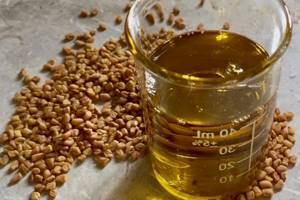
Face masks
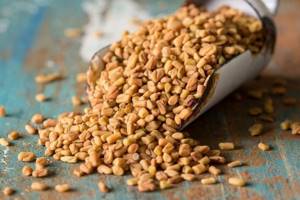
For hair
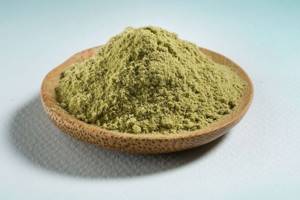
Oil for breast shape correction
To improve the shape of the bust, mix 50 ml of linseed oil and 8 drops of helba oil. Rub in a circular motion into the chest area counterclockwise. After 5-7 minutes we take a contrast shower. Repeating the procedure every 3 days makes the bust elastic and promotes enlargement.
Description
The plant has a taproot, straight, low, branching stems. The leaves are petiolate, the flowers are small, located on short stalks. Fenugreek fruits are curved or straight beans. Each fruit contains 10-20 seeds. They are rhombic or square, the color of the seeds is from brown to light yellow. Fenugreek blooms in early and mid-summer. The plant has a specific nutty aroma.
Fenugreek is native to Asia Minor and the Eastern Mediterranean. In the wild, the plant is also found in the northern Alps and Central Asia. Fenugreek is cultivated in Eastern Europe, Africa, Asia, and Latin America.
Even the inhabitants of Ancient Egypt and Ancient Greece ate this plant as a vegetable. The Brahmins of India used fenugreek leaves in their magical rites. The properties of the plant are described in several ancient Indian manuscripts. The Egyptians used fenugreek to induce labor and treat burns. Gladiators in Rome ate fenugreek seeds before battle to improve their vitality.
The Russian name of the plant comes from the word “pazhit”, which means pasture for livestock. Fenugreek was originally fed to cattle, giving rise to another name for fenugreek: Greek hay.
In what form is it sold, how to choose

When choosing a product, pay attention to the following points:
- High-quality grains have a golden-brown hue and look “full.” Dark and dried out seeds indicate that they have not been stored properly or are past their expiration date.
- The oil is transparent, golden in color, without flakes or dark sediment.
- When choosing capsules, pay attention to the shelf life. Discard medications that have less than 30 days left before their final sales date.
- Buy the powder hermetically sealed. Once the package or jar is opened, use within 3 months.
How to make tea
How to brew helba? The drink can be prepared like regular tea, but do not forget that this is an unusual drink. It consists not of leaves, but of beans; it is not enough to brew it with boiling water. The beans can't open up that quickly. Therefore, to obtain a healthy drink, fenugreek is boiled.
- The beans must be thoroughly washed and dried.
- Dry beans need to be fried in a frying pan and chopped.
- Pour 1 glass of water into a container, add a teaspoon of beans.
- Place the container on the fire and cook for ten minutes.
- Strain and let cool.
What's the benefit?
Egyptians value yellow tea not for its extraordinary taste. They got used to it a long time ago! The main treasure of such a drink is its healing properties. Among the people, Helba is surrounded by some semi-mythical facts, but doctors have their own data about its benefits.
Fenugreek seeds have antiseptic, anti-inflammatory, expectorant, and antipyretic effects. For some diseases, yellow tea will be more useful than other remedies.
- For diseases of the respiratory system (bronchitis, tuberculosis and pneumonia) as an adjuvant. Helba helps the expectoration process, relieves inflammation and removes harmful toxins from the body.
- If you have a cold, tea will lower your temperature and help you quickly return to your normal rhythm of life.
- For diseases of the gastrointestinal tract. Unlike many other teas, Helba does not irritate the gastric mucosa, but on the contrary, it gently envelops it and creates a strong protective layer. Fenugreek improves the functioning of the liver and gall bladder, suppresses pathogens. This drink stimulates the regeneration of the stomach walls and expels helminths from the body.
- For specific women's problems. In this case, the plant analogue of progesterone, phytoesterone diosgenin, acts. Helba, in combination with traditional drugs, will cope with polycystic and ovarian cysts, mastopathy and even female infertility. You should not drink this tea during menstruation! It will provoke increased bleeding. However, regular use on other days of the cycle will help cope with painful sensations in the first days of menstruation.
- During menopause, yellow tea reduces the unpleasant symptoms of this period.
- When breastfeeding, helba increases the amount of breast milk.
- For low libido and other sexual disorders.
- For diseases of the excretory system. The drink has bactericidal properties and helps destroy kidney stones.
- For chronic fatigue, memory disorders, decreased concentration, depression.
Fenugreek for weight loss - secrets of using the product
Nowadays, it is increasingly difficult to meet a person who would not be puzzled by the problem of losing weight. Among the variety of means for actively combating excess weight, nutritionists highlight fenugreek for weight loss. Thanks to this plant, you can not only lose extra pounds, but also strengthen the body as a whole.
Fenugreek - beneficial properties for women for weight loss
Helba, shambhala, chaman, fenugreek - this is what fenugreek is also called, which is a plant of the legume family. According to historical data, this product has been used by humanity for many centuries. The taste of the seeds of this plant resembles celery. True, some people note that its taste is associated with burnt sugar and even maple syrup.
A few centuries ago, fenugreek was famous for its beneficial properties, thanks to which women could get rid of a number of diseases. And, if you rely on historical data, then using this plant, it was possible to recover from labor, improve lactation and stabilize the menstrual cycle. Fenugreek was also used for weight loss, because its seeds helped cleanse the body of accumulated harmful substances.
Helba for weight loss has many advantages:
- improving the functioning of the cardiovascular system;
- acceleration of the removal of toxic substances and waste;
- normalization of blood pressure;
- stimulation of natural insulin production;
- stimulation of peristalsis;
- protection of the digestive mucosa from mechanical and chemical irritants;
- in combination with lemon and honey, fenugreek helps strengthen the immune system;
- restores hormonal levels;
- relieves PMS;
- helps to minimize the symptoms of menopause;
- relief of pain during labor.
The seeds of this herb are also actively used in cosmetology. Based on this component, various masks are produced to strengthen hair, eliminate dandruff, and improve hair growth. The powdered plant is used during food preparation. On supermarket shelves you can find a huge number of cheeses and meat products, which include chaman.
Fenugreek - use for weight loss
Due to its positive effects on the gastrointestinal tract, many nutritionists recommend using fenugreek as a means to enhance healthy fat loss. When considering how to use fenugreek for weight loss, to achieve a quick effect, you just need to brew the tea and use it throughout your diet. Thanks to this, the body will begin to actively fight accumulated waste and toxins that prevent the body cells from releasing excess fat.
Fenugreek helps to cope with the external manifestations of excess weight - cellulite. Based on this plant, all sorts of poultices are made that allow you to deal with “orange peel” at home, without resorting to expensive procedures. And not everyone is suitable for peelings, scrubs and other cosmetic procedures through which they fight cellulite.
Fenugreek seeds for weight loss
There are many different recipes for consuming fenugreek seeds (the second name is helba), but most often helba seeds for weight loss are used according to the following recipe:
Ingredients:
- one tablespoon of seeds;
- stevia infusion (preparation: pour 20 g of herb into a glass of boiling water and let it brew for half an hour);
- 200 ml of boiled water.
Preparation:
- A spoonful of raw materials is poured into a glass of boiling water.
- After the seeds have infused (this takes at least 10 hours), the resulting decoction is mixed with stevia infusion in a ratio of three parts shamballa and one part stevia.
- This drink is drunk immediately after preparation, after which it is not advisable to eat food or drink tea, coffee, etc. for the next three hours.
How to take fenugreek powder for weight loss?
Fenugreek, as a means for weight loss, is also taken in powder form. You can quickly grind the seeds using a primitive coffee grinder. So, in order to get rid of excess body weight, you should eat half a teaspoon of helba spice during meals. Crushed fenugreek is also used as a seasoning for a variety of dishes.
Fenugreek - tea for weight loss
It has been clinically proven that helba-based tea helps activate weight loss processes. But for such a drink to really help you cope with extra pounds, you need to know how to brew fenugreek for weight loss. In fact, the recipe for preparing a fat-burning drink based on it is very simple:
Ingredients:
- 3 tsp. fenugreek seeds;
- 1000 ml of boiled water.
Preparation:
- The seeds are lightly fried, and the field is poured with boiling water.
- Steamed seeds must be kept in a steam bath for 15 minutes.
- This tea is taken three times a day, 100 ml.
Fenugreek - contraindications
Despite the huge number of positive properties of the fenugreek spice, it also has contraindications:
- It is strictly prohibited to use for diabetes and pregnancy;
- If you have diseases accompanied by bleeding or if there is a hormonal imbalance, it is not recommended to take fenugreek for weight loss.
Related articles:
| Cellulose for weight loss and cleansing the body Cellulose for weight loss absorbs liquid in the body, swells, increasing in size, and thereby provides a feeling of satiety. It acts as a brush, removing decay products, waste and toxins, normalizing intestinal motility. | Sassi water for weight loss - recipes and rules for taking Sassi water for weight loss is an affordable and tasty drink that has a positive effect on the digestive system, improves metabolism and promotes fat burning processes. There are several recipes that differ in some ingredients. |
| Ginger tea for weight loss - the most effective recipes The healing properties of ginger for health were first appreciated in the East. The use of ginger tea for weight loss began a little later, when the ability of this remedy to improve metabolism was discovered. Finding out more about the spicy drink is useful both for those who want to lose weight and for those who want to improve their health. | Magnesia for weight loss - the benefits and harms of the method Tough but effective methods of losing weight have been and will be popular in the world. This topic is especially interesting for people who need to quickly and noticeably lose weight. Magnesia for weight loss can help with this. |
womanadvice.ru
Fenugreek - a miracle of African nature
We have already mentioned that helba and tea cannot be called in the literal sense of the word. Fenugreek seeds are used to make this drink. This plant grows not only in Egypt, but also in many other countries. However, only in the ancient homeland of the pharaohs is it consumed in this form. Fenugreek has many names. It is also called shamballa, camel grass and even goat trefoil.
Fenugreek was mentioned in the ancient works of Hippocrates, Avicenna and Chinese medieval scientists wrote about it. Now it is well studied by both doctors and biologists. This is an annual plant up to 70 cm high. The leaves and fruits have a pronounced odor due to the high content of coumarin. Fenugreek fruits resemble the familiar beans in appearance. They ripen in large pods.
Shambhala seeds themselves are rich in various elements beneficial to the human body. It includes:
Those watching their weight will be interested to know this! A teaspoon of fenugreek beans contains 12 kcal.
Yellow tea: discovering new feelings
It is difficult to surprise a modern person with anything. This is especially true for his gastronomic preferences. But Egyptian helba tea will be a discovery even for experienced connoisseurs. Yellow teas are also produced in the Middle Kingdom, but Helba is a drink of a completely different quality. This drink is made not from leaves, as we are used to, but from the seeds of the plant. Residents of Egypt love to drink this tea and certainly treat it to guests of their ancient country.
The taste of yellow tea is difficult to compare with something already familiar. It has vanilla, nutty, even chocolate notes. And all the familiar flavors in helbe feel as if they have been rediscovered. Some people need time to get used to new sensations.
How to drink yellow tea correctly
Egyptian tea has amazing properties; it is strikingly different from other teas. When hot, this drink warms you up, and when cold it perfectly quenches your thirst. To discover a new taste, just throw a few dates into brewed tea.
Add ginger, honey, cinnamon to taste. The drink turns out very aromatic. The taste of tea is interesting, some compare it with the taste of cheese, mushrooms, others with the taste of spices. Water can be replaced with milk; helba tea with milk is an ancient Egyptian way of preparing the drink.
Preparing yellow tea correctly
The process of preparing Helba differs from brewing other teas. In this case, we are not dealing with leaves, but with beans. Out of habit, no one forbids pouring boiling water over the seeds. But this way, fenugreek will not reveal its beneficial properties, and the drink will turn out to be a dummy.
You need to follow these rules.
- Rinse the seeds first and dry them thoroughly. This process usually takes several days.
- Roast the beans and grind them in a regular coffee grinder.
- Add the required amount of water to the pan. Add ground beans - 1 teaspoon per 250 ml.
- Boil the drink over low heat for 8-10 minutes.
- Drink the tea slightly cooled. If possible, add honey instead of sugar. Ginger or cinnamon would be good additions to the drink.
Instead of water, you can therefore use milk in the same recipe. This tea is recommended to drink for male impotence.
Fenugreek (helba, hilba, shamballa) for breast enlargement, hair growth, potency... “Helba yellow tea”, properties of helba
Fenugreek or helba (hilba) is one of the effective remedies for breast enlargement, hair growth, weight loss, clear skin, women's health, painful menstruation and intestinal disorders, potency problems, sexual disorders, etc.
Fenugreek is popular in many countries of the world, therefore it has a huge number of names (synonyms). Here are just a few of them: helba, hilba, shamballa, camel thorn, fenugreek, fenum-Greek, fenigreek grass, Greek hay, Greek goat's trefoil, Greek sochevitsa, cocked hat, camel grass.
Fenugreek (helba) grows in southeastern Europe, India, Argentina, Egypt, France and Morocco, has a pleasant spicy, slightly bitter taste and a specific, unparalleled smell.
Today, fenugreek (helba) is easy to purchase, many of us have helba seeds or oil on the shelf, but do we know about all the beneficial properties of helba? The Prophet Muhammad (peace and blessings be upon him) spoke about the healing properties of fenugreek (helba) back in the 7th century. . Here, for example, is his statement: “Heal yourself with helba!” clearly indicates the medicinal properties of this plant. If, when using helba, we make the intention to follow the Sunnah, then insha Allah, in addition to health in this world, we will also gain the pleasure of the Almighty and His Messenger (peace and blessings be upon him).
The statement of Arab doctors: “If only people knew how much benefit there is in helba, they would buy it for the price of gold” inspires respect for this difficult plant.
Much later, one of the famous English scientists Kleber said: “If all the medicines on the planet are put on one side of the scale, and Helba is put on the other side, then the scales will balance.”
The healing properties of fenugreek (helba) were highly valued by Hippocrates. In Ancient Egypt, fenugreek (helba) was used to facilitate childbirth and enhance lactation. From medical treatises on papyri found in Egyptian tombs, it is known that fenugreek (helba) was used not only in cooking, but also as an effective antipyretic. In the Middle Ages, fenugreek was used to treat premature baldness. Arab women from Syria to Libya eat roasted shamballa seeds to give them roundness to their breasts and hips, and roundness is known to be considered the ideal of beauty in the East.
ATTENTION! Contraindicated during pregnancy, may cause miscarriage and bleeding!

